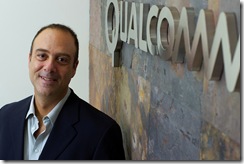Mobile health (mHealth) is a growing vertical market around the world, though the size of the opportunities that exist are yet to be fully quantified. Gilles Fayad, director of business development, VAS, MENA at Qualcomm believes localisation of needs and solutions will be an integral component of the mass market take up of such services
Gilles Fayad forecasts there will be as many as 400 million wireless sensors used for medical monitoring by 2015, with the communications networks playing a central role in allowing remote monitoring and diagnosis to take place. He believes that the localisation of mHealth is an important facet to the ecosystem’s development, and should be tailored to fit cultures and geographies.
“Qualcomm is developing devices in partnership with medical care companies and telecom service providers,” Fayad says. “Phones and gateways (which allow an individual to establish a home network) are the instruments driving mHealth at this current point in time,” he adds.
The rollout of communications networks to rural areas is occurring in cooperation with government programmes that can utilise the infrastructure, and Fayad believes the issue of localisation has been identified in many regions as being important and is being worked upon.
Qualcomm is helping develop the wireless health global ecosystem, assisting sufferers of ailments to be able to manage their conditions remotely, either via a mobile device or dedicated medical device. One of the first systems Qualcomm developed was a remote monitoring kit that can be utilised by a remote caregiver.
“Wellness and fitness applications are understood and available,” says Fayad. “In terms of monitoring of diseases and ailments, sufferers are often acutely aware of their conditions and go out looking for solutions.”
According to Thierry Zylberberg, executive VP, Strategic Partnerships and GM of the Health Business at Orange-France Telecom, the business for medical device instruments is booming with companies that were start-ups 10 years ago looking to focus on their core business. These medical device manufacturers have begun entering partnerships with companies that transport the information, leading to the development and growth of mHealth applications.
“Data collection and remote monitoring are the main mHealth applications being used in Africa,” Zylberberg says. “Health management is where the largest opportunity to exploit exists, and it already contributes around 50 per cent of mHealth revenues currently,” he adds.
Orange launched its health division about three years ago, and has products that have now started coming to market. The development of electronic and mobile health products is slow, which is intrinsic in the medical world as advancements are typically consensus based.
“We don’t expect things in mHealth to grow exponentially like in the IT industry,” Zylberberg asserts. “There are many stakeholders, and not all of them are aligned,” he adds.
The developing mHealth ecosystem consists of the software industry, the telecom providers and the device manufacturers, all of which stand to gain from industry collaboration and cooperation. In Serbia for example, domestic cellco Telecom Serbia operates a teleassistance service through which patients can monitor their health indicators remotely. The service provider generates revenues through receiving part of the proceeds from the rental of the medical device, and a successful pilot of the service has been rolled out in Serbia’s capital, Belgrade.
Qualcomm’s Fayad believes that in order for mHealth services to be adopted and utilised effectively in emerging markets such as the Middle East and Africa, governments need to play a role in ensuring compliance and fostering a transparent mechanism with respect to who pays for the delivery of such services, and how they are paid for.
Insurance companies are often the players directly or indirectly involved in the fostering and support of mHealth services and mechanisms ought to be put in place to allow those suffering from ailments and caregivers to be given easy access to products.





0 comments ↓
There are no comments yet...Kick things off by filling out the form below.
Leave a Comment